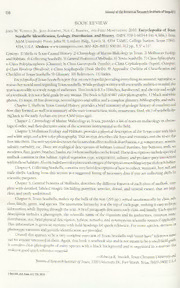
Preview BOOK REVIEW
Journal of the Botanical Research Institute of Texas 130 6(1) BOOK REVIEW Encyclopedia John W. Tunnell Jean Andrews, Noe C. Barrera, and Fabio Moretzsohn. 2010. of Texas Jr., and 978-1-60344-141-4, Seashells: Identification, Ecology, Distribution, History. (ISBN: hbk.). Texas A&M TAMU, University Press, John H. Lindsey Bldg,, Lewis St. 4354 College Station, Texas 77843- www.taraupress.com, 800-826-8911). $50.00, 512 8.5" x 11". 4354, U.S.A. (Orders: pp., Contents: Shells in Texas Coastal History. 2) Chronology of Marine Malcology in Texas. 3) Molluscan Ecology 1) and Habitats. 4) Collecting Seashells. 5) General Features of Mollusks. 6) Texas Seashells. 7) Class Aplacophora; Cephalopoda a-Class Polyplacophora (Chitons); b-Class Gastropoda (Snails); c-Class (Squid, Octopus); Scaphopoda (Tusk Appendix: Outline of Classification and d-Class Bivalvia (Bivalves); e-Class Shells). 8) Checklist of Texas Seashells. 9) Glossary. 10) References. 11) Index. Encyclopedia of Texas Seashells is just that: an encyclopedia providing everything an amateur, naturalist, or researcher would need regarding Texas seashells. While perhaps written with a scientific audience in mind, this text is accessible to a wide range of audiences. This book is 8.5 x llinches, hardbound, and the size and weight of a textbook; it is not a field guide by any means. The book is full of 987 color photographs, 12 black and white photos, 15 maps, 18 line drawings, several figures and tables, and a complete glossary, bibliography, and index. summary and Chapter Shells in Texas Coastal History, provides a brief of geologic history of coastlines 1, how summary they formed, as well as a of the uses (construction, tools, ornaments, food, etc.) of seashells dat- ing back to the early Archaic era (over 4,500 years ago). Chapter Chronology of Marine Malacology in Texas, provides a of texts on malacology in chrono* 1 2, list logical order, and then discusses some of the scientists instrumental to the field. Chapter Molluscan Ecology and Habitats, provides a physical description of the Texas coast with black 3, and white maps and a few color photographs. This section describes the bays and estuaries and the rivers that flow into them. The next section discusses the factors that affect mollusk distribution, temperature, seasons, e.g. salinity, turbidity, etc. There are ecological descriptions of habitats (coastal marshes, bay bottoms, reefs, sea meadows, flats, jetties, beaches, banks, etc.) where mollusks can be found. These descriptions include species of common mollusk in that habitat, typical vegetation type, temperature, and predator-prey interactions salinity, within these habitats. Also includedarecolorplates with imagesofthespecies assemblages typicalofeachhabitat Chapter how and 4, Collecting Seashells, contains very brief descriptions of to maintain, buy, sell, collect, Lacking from trade shells. this section is a suggested listing of necessary data you are collecting shells for if purposes. scientific Chapter 5, General Features of Mollusks, describes the different feature plete with detailed, labeled images (including posterior, anterior, dorsal, an and clear, easily understood. Chapter Texas makes up bulk 6, Seashells, the of the text (295 son pp.), and The class, family, genus, species. taxonomic hierarchy is at the top of each page, making easy it t< A information while flipping through the text. brief paragraph discusses each class and family. Each description includes a photograph, the scientific name of the organism and common its authorities, distribution, size, brief physical description, habitat, remarks, and synonymous names applicable. if s< ic This information on is given in sections with bold headings quick sections for reference. Fc e species, phenotypic variation and juvenile identification are provided. Overall this appears to be a very complete overview of Texas Seashells and “must have” reference mate- anyone rial for interested in them. Again, this book is textbook size and is not meant to be a small field guide. contains It clear photographs of every species with a black background and organized in a manner that is makes good quick it reference material. —Rebecca and, K. Swadek, Texas Christian University U.SA Botanical Research Institute of Texas, 1700 University Dr., Fort Worth, Texas 76107-3400, | Sot J. Res. Inst Texas 6(1):
